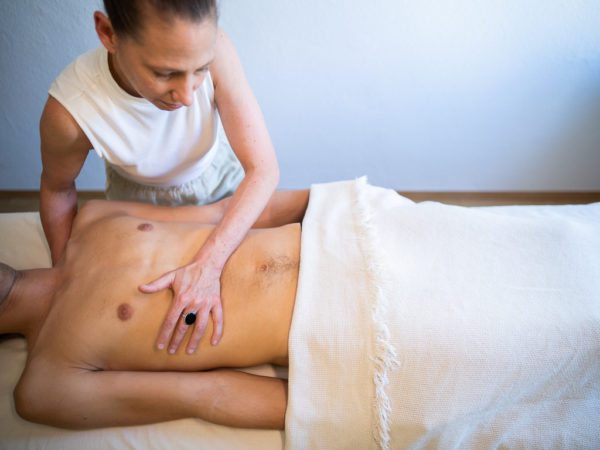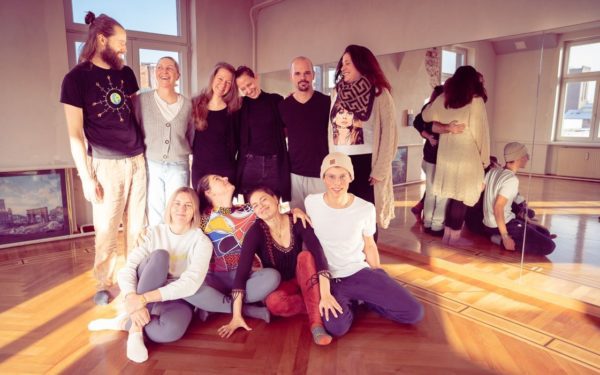The physical shock reaction
Jedes Erlebnis, jedes schöne Gefühl, jedes Trauma hat eine körperliche Reaktion zur Folge. In einer bedrohlichen Situation läuft ein Automatismus im Körper ab und bestimmte Regionen werden wie im Schock weiterhin so gut als möglich innerviert, andere nicht. Zum Beispiel zentralisiert der Körper das Blut und stellt die Versorgung der Extremitäten ein. Nun ist es jedoch so, dass bestimmte Strukturen besonders in jenen Stresssituationen besonders benötigt werden, um uns in der aufrechten Körperhaltung zu belassen und uns reaktiv zu halten. Dies sind die Membrane Interossea im Unterschenkel und im Unterarm, das Zwerchfell und die Membran im Unterkiefer. Bei der Unterversorgung durch den körpereigenen Schockmechanismus kommt es zu einer Überlastung in ihnen und somit sind genau diese vier Strukturen nach chronischen oder wiederholten Erlebnissen ähnlicher Art, spürbar und sichtbar betroffen.

The four trauma catchers
When I work with my clients on those affected membranes, I try to support them to befriend with the four particular membranes well, and that is why I compare them to Native American dream catchers. Just as bad dreams get caught in the web of the dream catcher, trauma also gathers in the membranes. Therefore, membranes function like "trauma catchers."
When we as therapists get in touch with the areas in the body that hold these traumas, we enter into a kind of nonverbal communication with the body's memory, even more so: we allow our client's body to get in touch with its own experiences. That means, we as therapists can support the system to put new information on former traumas and allow the supply of the whole system to reestablish a balance. Traumatic experiences can thus be perceived and integrated anew.
The four most prominent and thus significant of these membranes are these:
Membrana Interossea of lower leg
The Membrana Interossea between the calf bone and the shin bone tells us about those traumas that "pulled / pull away the ground from under our feet".
Wir können einerseits in der Bewegungsanalyse erkennen, wie die Fibula und Tibia zueinanderstehen. Wir können Dysbalancen der Membran an der Fußstellung des oberen Sprunggelenkes oder am Knie- und weiterverlaufenden Hüftverhalten beobachten. Wenn wir die Membran palpieren und achtsam sind und mit Erlaubnis des Körpers den wir berühren in einzelne „Schichten“ des Unterhautgewebes eingeladen werden, bemerken wir, wie „tief“ die Verspannungen liegen, ob ihnen ein großes oder kleines, ein wiederholtes, ein lang vergessenes oder ein neues Trauma zugrunde liegen mag. Es geht hier im großen Ganzen um Themen, die mit dem Vertrauen zu tun haben. Die linke Membran spricht oft von Dingen, die unser Gefühl ansprechen und die rechte meldet eher Sicherheit und Fairness.

Diaphragm
The diaphragm of the diaphragm tells us about all those traumas that "have taken / are taking away our air to breathe".
On the one hand, we can see how the membrane of the diaphragm behaves in breathing and movement analysis. The diaphragm is a very complex system and is directly connected through its muscle to the lumbar spine and the entire organ system. We can observe membrane imbalances at the spinal curve. If we palpitate the ribs and the middle of the body and are mindful and, with the permission of the body that we touch, and are invited into individual "layers" of the subcutaneous tissue, we notice how "deep" the tension is, whether an organ can be assigned to it or whether it primarily affects the diaphragm, whether a major or minor, repeated, long-forgotten or new trauma may underlie it. On the whole, these are issues that have to do with the fact that we feel "locked up" inside.
Membrana Interossea of forearm
The Membrana Interossea between the ulna and the radius tells us about the traumas that "incapacitate us".
On the one hand, we can see in movement analysis how ulna and radius are related to each other. We can see membrane imbalances in the hand and arm movements or even observe them in the complex shoulder apparatus. If we palpate the membrane and are attentive and, with the permission of the body we are touching, we are invited into individual "layers" of the subcutaneous tissue, then we notice how "deep" the tensions are, whether they are caused by a major or minor, repeated, long forgotten or new trauma. On the whole, we are dealing here with issues that have to do with action. The left membrane often talks about things that appeal to our feelings and self-love / self-esteem and the right membrane tends to report security and life issues such as job. And it is about being prevented from acting or not daring to act through these traumas.
Mandibular membrane
There are traumas in the lower jaw that we either cannot or that we do not want to see nor name.
This is probably the most challenging part of the body when it comes to trauma. I like to talk about those incidents that we do not want to or cannot name. We might even not actively know about them, because they may not come from this life of ours. If a client is experiencing grinding, biting, chronic jaw tension or headaches, perhaps even if she/he talks extremely much or even extremely little, also if there is an unusual eating behaviour involved, then such events are probably at play. The body system is whispering here for certain. And it remains silent while talking. And it is up to us therapists to speak to it indirectly and to invite it to understand, to see, to let go and to integrate. We proceed as in all other membranes, only more attentive, careful, indirect and silent.

Are you curious in learning more about how traumas manifests itself across all bodies and how we can deal with them on every imaginable layer? Then sign up for one of our courses.
I am much looking forward.
Julia